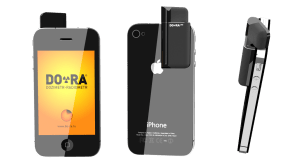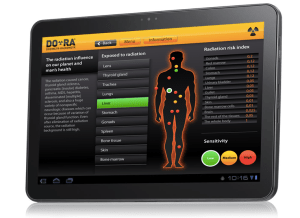There’s a thriving cottage industry of smartphone extension hardware that plugs into the headphone jack on your phone and extends its capabilities in one way or another — feeding whatever special data it grabs back to an app where you get to parse, poke and prod it. It’s hard to keep track of the cool stuff people are coming up with to augment phones — whether it’s wind meters or light meters or even borescopes. Well, here’s an even more off-the-wall extension: meet DO-RA — a personal dosimeter-radiometer for measuring background radiation.
Granted, this is not something the average person might feel they need. And yet factor in the quantified self/health tracking trend and there is likely a potential market in piquing the interest of quantified selfers curious about how much background radiation they are exposed to every day. Plus there are of course obvious use-cases in specific regions that have suffered major nuclear incidents, like Fukushima or Chernobyl, or for people who work in the nuclear industry. DO-RA’s creators says Japan is going to be a key target market when they go into production. Other targets are the U.S. and Europe. It reckons it will initially be able to ship 1 million DO-RA devices per year into these three markets. The device is due to go into commercial production this autumn.
Granted, this is not something the average person might feel they need. And yet factor in the quantified self/health tracking trend and there is likely a potential market in piquing the interest of quantified selfers curious about how much background radiation they are exposed to every day. Plus there are of course obvious use-cases in specific regions that have suffered major nuclear incidents, like Fukushima or Chernobyl, or for people who work in the nuclear industry. DO-RA’s creators says Japan is going to be a key target market when they go into production. Other targets are the U.S. and Europe. It reckons it will initially be able to ship 1 million DO-RA devices per year into these three markets. The device is due to go into commercial production this autumn.
The Russian startup behind DO-RA, Intersoft Eurasia, claims to have garnered 1,300 pre-orders for the device over the last few months, without doing any dedicated advertising — the majority of pre-orderers are apparently (and incidentally) male iPhone and iPad owners. So it sounds like it’s ticking a fair few folks’ ‘cool gadget’ box already.
The DO-RA device will retail for around $150 — which Intersoft says is its primary disruption, being considerably lower than rival portable dosimeters, typically costing $250-$400. It names its main competitors as devices made by U.S. company Scosche, and Japanese carrier NTT DoCoMo. Last year Japan’s Softbank also announced a smartphone with an integrated radiation dosimeter, with the phone made by Sharp. This year, a San Francisco-based startup has also entered the space, with a personal environmental monitoring device, called Lapka (also costing circa $250), so interest in environmental-monitoring devices certainly appears to be on the rise.
DO-RA — which is short for dosimeter-radiometer — was conceived by its Russian creator, Vladimir Elin, after reading articles on the Fukushima Daiichi nuclear disaster in Japan, and stumbling across the idea of a portable dosimeter. A bit more research followed, patents were filed and an international patent was granted on the DO-RA concept in Ukraine, in November last year. Intersoft has made several prototypes since 2011 — and produced multiple apps, for pretty much every mobile and desktop platform going — but is only now gearing up to get the hardware product into market. (Its existing apps are currently running in a dummy simulation mode.)
So what exactly does DO-RA do? The universal design version of the gadget will plug into the audio jack on a smartphone, tablet or laptop and, when used in conjunction with the DO-RA app, will be able to record radiation measurements — using a silicon-based ionizing radiation sensor — to build up a picture of radiation exposure for the mobile owner or at a particular location (if you’re using it with a less portable desktop device).
The system can continuously monitor background radiation levels, when the app is used in radiometer mode (which is presumably going to be the more battery-draining option — albeit the device contains its own battery), taking measurements every four seconds. There’s also a dosimeter mode, where the app measures “an equivalent exposure over the monitoring period” and then forecasts annual exposure based on that snapshot.
The DO-RA device will retail for around $150 — which Intersoft says is its primary disruption, being considerably lower than rival portable dosimeters, typically costing $250-$400. It names its main competitors as devices made by U.S. company Scosche, and Japanese carrier NTT DoCoMo. Last year Japan’s Softbank also announced a smartphone with an integrated radiation dosimeter, with the phone made by Sharp. This year, a San Francisco-based startup has also entered the space, with a personal environmental monitoring device, called Lapka (also costing circa $250), so interest in environmental-monitoring devices certainly appears to be on the rise.
DO-RA — which is short for dosimeter-radiometer — was conceived by its Russian creator, Vladimir Elin, after reading articles on the Fukushima Daiichi nuclear disaster in Japan, and stumbling across the idea of a portable dosimeter. A bit more research followed, patents were filed and an international patent was granted on the DO-RA concept in Ukraine, in November last year. Intersoft has made several prototypes since 2011 — and produced multiple apps, for pretty much every mobile and desktop platform going — but is only now gearing up to get the hardware product into market. (Its existing apps are currently running in a dummy simulation mode.)
So what exactly does DO-RA do? The universal design version of the gadget will plug into the audio jack on a smartphone, tablet or laptop and, when used in conjunction with the DO-RA app, will be able to record radiation measurements — using a silicon-based ionizing radiation sensor — to build up a picture of radiation exposure for the mobile owner or at a particular location (if you’re using it with a less portable desktop device).
The system can continuously monitor background radiation levels, when the app is used in radiometer mode (which is presumably going to be the more battery-draining option — albeit the device contains its own battery), taking measurements every four seconds. There’s also a dosimeter mode, where the app measures “an equivalent exposure over the monitoring period” and then forecasts annual exposure based on that snapshot.









